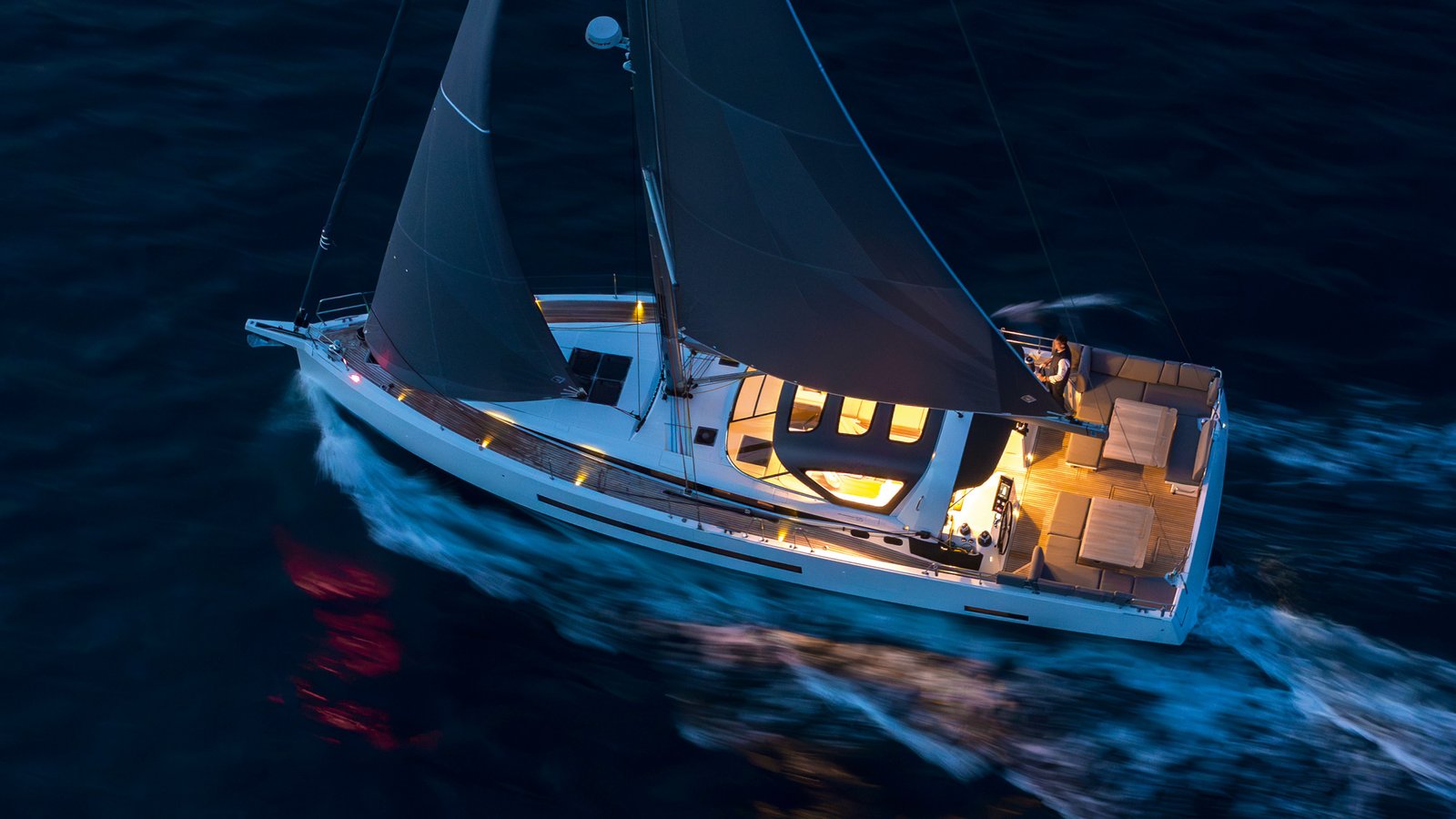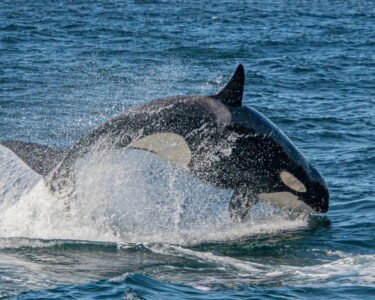Boatbuilders rarely have the courage to launch a model that represents a radically different way of thinking. Instead, most new yachts are simply variations on established themes with incremental improvements that represent important evolutions over time.
And when testing boats it’s easy to gloss over what it’s like to spend time relaxing on board, whether in harbour or underway in lovely weather. Yet this is a critical factor in the enjoyment owners derive from their boats.
Even with the best natural ventilation, in tropical sun or when the outside temperature rises above 30˚C, the interior of any yacht gets uncomfortably hot. So why have monohull builders and designers continued to expend so much effort on optimising saloon and dining space below decks, rather than focussing on exterior socialising and relaxation spaces?
The Jeanneau Yachts 55 completely reimagines how the main living areas on a yacht intended for use in sunny climes should be configured. All key elements of the main saloon are effectively on deck, sheltered by a big sprayhood and hard top or bimini. It reflects how yachts are actually used, at the same time improving privacy in each of the sleeping cabins and in the owner’s quarters.
In a sense it merely recognises how many people use a boat with decent sun protection: maximising time spent in the cockpit.
While this is not the yard’s first foray into this concept of accommodation arrangement it’s the first model aimed at private owners. It draws on Jeanneau’s experience with the Sun Loft 47 of 2019, which was geared resolutely for the charter market. We got to put a pre production model of the Jeanneau Yachts 55 to the test in Spain last autumn.

A pair of electric winches at each helm station allow for push-button sail handling. Photo: Gilles Martin-Raget
Novel layout
The cockpit effectively extends a huge distance forward and has multiple different spaces for different purposes. Right aft is a full-beam flexible area with expansive sunbeds that convert to large tables, creating a space that easily rivals the aft cockpit of multihulls of a similar size. As with flybridge catamarans and motor yachts, cushions are a fast drying type made for use outdoors.
Immediately ahead of this area is the main control centre for the boat, with twin helm and winch stations. These have a pair of Harken electric winches each side, with one having a back-winding facility, and on the test boat all furling and reefing could be done electrically by one person.
The distinctive mainsheet arch is standard on all boats, whether or not the optional solid sprayhood and hard top are specified over the standard fabric components. This has the big benefit of keeping the sheet safely clear of the cockpit, however the standard arrangement doesn’t allow for fine control of sail shape.
Article continues below…
There’s something surprising and quite brilliant about the new Beneteau Oceanis Yacht 54, which I bet you won’t notice at…
£560,000.00
Lagoon has sold 900 of its 450 catamaran model in eight years, maxing out the 130-a-year mould capacity in latter…
Outboard of the wheels the side decks slope upwards towards the foredeck in a refinement of the ramp first seen on the Sun Odyssey 440 back in 2017. This arrangement works really well on the Jeanneau Yachts 55, giving easy step-free access to the foredeck. It also effectively creates a deep bulwark, with an extra high 36in rail outboard of the winches, making it a safe place for sail handling. There are also lovely deep rope bags here, though longer handrails on the coachroof sides for use when going forward would be beneficial.
The two well appointed ensuite guest cabins are immediately forward of the helm stations. These are accessed from on deck, below the shelter of the hard top, which provides more privacy at night than a conventional arrangement with quarter cabins accessed directly from the saloon. The port is the larger of the two, with more floor area and space for a compact two-seater sofa.
On the downside guests have to descend into the depths of the hull via steep steps, so there’s potential for these cabins to feel claustrophobic, access to the starboard cabin’s heads is awkward, and the galley can only be reached by climbing up into the cockpit, then back down the main companionway.

Side decks slope up to the foredeck, while deep bulwarks make it a safe space to handle sails. Photo: Gilles Martin-Raget
The arrangement is great for owner’s privacy, and fine if you have teenage kids, but won’t suit everyone, especially those with children under a certain age.
Ahead of the guest cabins, towards the front of the sprayhood, is a small four-person dinette/coffee table to starboard and a navstation to port.
Both are slightly raised to give a good all-round view and the dinette can be lowered to create yet another day bed. This also makes it a good space to take a nap on short-handed passages, when you might need to be available at short notice.
Equally the navstation is an ideal place from which to con the boat when on watch alone, when the dished seat will help you stay in place when heeled on port tack. It also makes a great place to work using a laptop, as long as the almost all-round view doesn’t prove too much of a distraction. If it does there’s a secluded desk/dressing table in the forward master cabin.

Outdoor living begins at the stern with sunbeds, loungers and dining tables that easily rivals many multihulls for space. Photo: Gilles Martin-Raget
Monocat sailing
What about sailing performance? Naval architect Philippe Briand has created a boat with relatively low freeboard and powerful hull sections, plus plenty of form stability that on paper ought to hold its own against other mainstream cruising yachts of similar size.
More often than not, the yachts provided for our tests have the optional deep keel married to a taller rig with a slab reefing mainsail that typically gives 20% or more extra sail area than standard. This enables us to get a good feel for the fundamental qualities of the hull design.
However, the Jeanneau Yachts 55 we tested had the 1.9m shoal draught keel, along with the standard size furling mainsail and self tacking jib, albeit with upgraded sailcloth.
At the same time, the test boat’s displacement was some 3.5 tonnes heavier than standard, thanks to the shoal keel (800kg), plus the solid sprayhood and hard top in place of the standard fabric sprayhood and bimini, a washer-drier, air conditioning and a diesel generator.

Raised dinette and navstation are forward of the mainsheet arch, under the sprayhood. Photo: Gilles Martin-Raget
It was difficult to make the furling main set well in the very light airs of my first day on board and, frustratingly, there was neither a Code 0 nor an asymmetric spinnaker on board. On the plus side, my experience is arguably a more realistic reflection of the configuration in which up to 90% of these boats will be ordered.
Many new designs impress with the way they sail in light airs – an important factor for summer cruising in Europe. However, this boat had very little feel or heel until the wind got above 7 knots, when we started making reasonable progress at just over five knots on a close reach, despite the restricted sail area. In only 4-5 knots of breeze we struggled to reach even three knots of boat speed, irrespective of wind angle.
Happily my second day on board produced 10-12 knots of breeze in which we made 5.5 knots close-hauled at a true wind angle of 55º, despite the boat being repeatedly slowed by a swell right on the bow. Bearing away with the true wind just aft of the beam, and that awkward swell on the quarter, we made a consistent 6-7 knots under main and jib.
The boat tracked well in these conditions, despite imperfectly set up steering: there was play, friction and vibration in the system, though we’re told these problems will be resolved on production boats.
Nevertheless, the helm stations are nicely configured, with big comfortable seats and large MFDs each side. There’s also excellent protection from sun, rain and spray, yet you can also steer sitting well outboard on the coaming to get a better view of the headsail luff, although the MFD and instruments are difficult to read from this position.

Dual helms, access to aft cabins and forward lounging area can all be under cover of the long bimini. Photo: Gilles Martin-Raget
Are the seating and sunbed arrangements aft viable when there’s more wind and sea? There was much discussion about this at the start of the European Yacht of the Year trials. I sailed with the sunbed on one side, and table with space to seat six to eight people on the other, an arrangement with obvious appeal at anchor or at a boat show.
With seven people on board, in a Force 3-4 breeze and uncomfortable swell, this area aft was favoured over the more sheltered and secure seating further forward, even when close-hauled. In these conditions it felt safe, though in rough weather and high angles of heel it would be a less inviting space, while the width of this area and its proximity to the transom would undoubtedly make it feel insecure.
Given the Jeanneau Yachts 55’s accent on outdoor living, along with Jeanneau’s emphasis that the main below decks accommodation is primarily for owner’s use, it’s surprising they didn’t create a more comprehensive outdoor galley, even if that would inevitably compromise other elements. Instead there’s an optional barbecue that swings out from under one of the aft seats, so you need to stand on the bathing platform to use it, plus an optional fridge drawer under a seat further forward.
Returning to port with a quartering swell the boat rolled enough to make you think why not buy a catamaran instead? There’s a multitude of answers to that question, of course. For example, for anyone who spends a lot of time in the Mediterranean at busy times of the year it’s usually much easier to find a visitor’s berth for a monohull, whether in a chic Ligurian marina or a bustling Greek town quay.
Of course multihull owners may counter that by pointing out that catamarans don’t have a monohull’s tendency to roll in an uncomfortable anchorage and you can often anchor off and dinghy ashore with a decent tender – but that’s not always feasible.

Double doors at the forward end of the saloon/galley lead through to the owner’s suite. Photo: Gilles Martin-Raget
Designed for the owners
All the space on deck makes this feel in some ways like a much larger yacht than the overall length might suggest, so descending the companionway is a surprise as it feels small for a 55-footer. But that initial impression misunderstands the whole concept of this boat.
Unlike almost any other yacht, the idea is the main below deck spaces accessed via the companionway will be predominately the preserve of the owners. This highlights how much of a change of mindset is needed to accurately evaluate this boat.
To starboard is a very long and very well appointed galley, and a saloon/dining area with space for six people to port. There’s lots of room to move around here – proportions are those of a smart apartment – though the wide open expanse may present a challenge at sea in rough conditions.

Well appointed linear galley is to starboard. Photo: Gilles Martin-Raget
Double doors in the main bulkhead open onto a properly spacious full width owner’s cabin with a wonderfully open feel and the peninsula bed offset to port. To some extent the feeling of space comes at the expense of stowage volumes, but there’s an option to replace the vanity desk here with a big wardrobe, while retaining the small sofa to starboard.
There’s also an excellent almost full width head and shower right forward, but it’s surprising there’s no provision for an easily accessed day head in addition to the three ensuites.
Stowage on deck includes a huge sail locker forward that’s large enough to be fitted out as an optional skipper cabin. There’s also a big lazarette aft, measuring 2.1 x 1.5 x 0.35m, where you might otherwise expect to find a tender garage. This has access from on top, as well as from the bathing platform, making an excellent wet storage area for fenders, watersports toys and so on. There’s also a dedicated liferaft locker.
Optional telescopic davits have a capacity of more than 100kg, sufficient for an aluminium RIB of up to around 3.5m with a tiller-steered outboard. This is arguably a better option than a tender garage, which invariably severely limits the size of dinghy that can be carried without significantly reducing the volume available aft for accommodation.

Port side is the larger of the two guest cabins and has room for a small sofa. Photo: Gilles Martin-Raget
An optional retractable gangway to port means access to the water, or to a quay when berthed stern to, is available even when the tender is stowed on the davits and the central transom walkway is therefore not available.
The pilot rams and steering gear are accessed through a hatch at the side of the lazarette that’s just wide enough to crawl through, before rotating yourself 90º to the right. This would make it very difficult to access at sea and some will find it difficult even in port.
The standard twin 380lt fresh water tanks are a decent size for a boat with only three double cabins and there’s a high capacity 36lt per minute water pump for near domestic levels of water pressure. However, the 230lt fuel tank is definitely on the small side for the 110hp engine. Engine, generator and other systems are installed in a tunnel between the guest cabins, accessed from cockpit hatches, and therefore nicely separated from the main interior accommodation.
Hull construction is vacuum infused polyester, with solid laminate in the keel area, while the matrix in the bilge that helps spread keel loads is glued in place. The standard of finish generally looks very neat and the interior joinery is well executed. However, integration of the optional hardtop elements with the mainsheet arch and optional solid windscreen are not as slick.
This means there’s a lack of clean lines and continuity in styling terms. From a distance it looks good, but close up there are too many changes of surface level to look really clean, tidy and stylish.
 If you enjoyed this….
If you enjoyed this….
Yachting World is the world’s leading magazine for bluewater cruisers and offshore sailors. Every month we have inspirational adventures and practical features to help you realise your sailing dreams.
Build your knowledge with a subscription delivered to your door. See our latest offers and save at least 30% off the cover price.
Verdict
This model represents a big bet and a bold move for Jeanneau that effectively creates a new type of yacht for private owners. When I first saw it at Düsseldorf in January 2023 I was taken with the concept, and the obvious enthusiasm Philippe Briand and Ignacio Oliva-Velex of renowned interior designers Winch Design have for it. Of course the Jeanneau Yachts 55 won’t suit everyone, and there are many who wouldn’t consider this boat, but it has potential to be a good match for many others. Admittedly the price of the pre-production test boat we sailed was inflated thanks to a very long list of extras. However, there are ways in which it didn’t feel like a $1million yacht, even if some elements such as the owner’s cabin and the expansive seating/sunbed areas aft are very nicely executed. Nevertheless the core idea clearly works well and aspects of it can’t easily be replicated on a multihull. Jeanneau plans to build 15 boats each year, so doesn’t require a huge production run for it to be considered a success. Even though this part of the market tends to be very conservative, 17 Jeanneau Yacht 55s have already been sold and we can surely expect to see more production designs for private boat owners along similar lines in future.
Details
LOA:16.98m / 55ft 9in
Hull length:16.15m / 52ft 11in
LWL:16.02m / 52ft 6in
Beam:4.99m / 16ft 4in
Draught (std keel):2.45m / 8ft 0in
Draught (shoal keel):1.9m / 6ft 2in
Displacement:19,311kg / 42,573lb
Ballast (standard keel):4.900kg / 10,803lb
Ballast (shoal keel):5,688kg / 12.540lb
Mainsail (fully battened):79m2 / 850ft2
Mainsail (furling):68m2 / 732ft2
110% genoa:75m2 / 807ft2
Self tacking jib:54m2 / 581ft2
Asymmetric spinnaker:250m2 / 2,690ft2
Fuel:230lt / 50gal
Water:760lt / 167gal
Base price:€696,900 ex VAT
Builder:www.jeanneau.com






